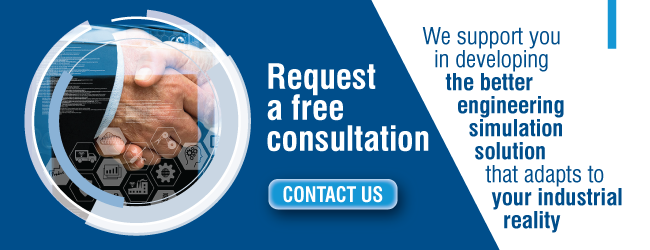
In the CAE sector new simulation methods continuously try to leave the embryonic or academic state to become mature and adopted by the industry. The success of this transformation depends on several factors, some related to the method itself, some other related to the “environmental conditions”, like the cultural readiness of the industry to rely and adopt new methods or the availability and affordability of hardware resources, that make these methods applicable at industrial level.
As in any natural process also in the world of simulation, the adaptability of the individual and the presence of favorable conditions play a vital role for the birth and growth on new methods. For sure in the last years more than before, the growing interest, awareness and also the increasing need for simulation have created the conditions for the rapid growth of new simulation techniques, that answer to un-responded engineering questions.
Computational Fluid Dynamics
If we refer more specifically to Computational Fluid Dynamics, the traditional Finite Volume method is well-established, accurate and well accepted in almost every industrial sector. There is a wide range of Finite Volume CFD codes, from commercial software to almost-open-source-codes, from general purpose to vertical software for specific applications, and one of the main trends in the last years has been the “democratization” of CFD simulation.
This means that CFD software has become simpler and faster to learn and use, it does not necessarily need advanced skills, at least for basic simulations, and it is now cheaper than before. In addition, the range of application, the depth and accuracy of Finite Volume CFD mod els has continuously grown.
The positive effect is that the use of CFD and simulation in general has moved from the last stages of the design process, with few simulations for design verification or to solve issues, to the early stages of the process, with tens of simulation to support and drive the design or even with hundreds of simulation to do multi-disciplinary optimization.
Nonetheless there are still some industrial applications for which Finite Volume CFD is still too complex, too computationally expensive with respect to the needs of the industry.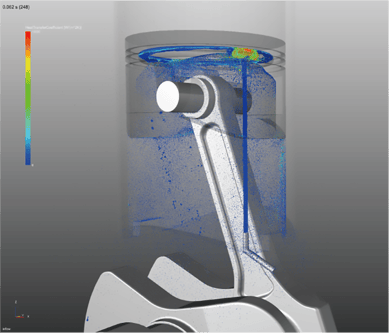
A clear example is the simulation of oil flow and lubrication in the drivetrain sector. Until few years ago, the prediction of oil behavior, of heat dissipation and churning losses in a transmission was practically unfeasible due to the geometrical complexity of the systems to be simulated, and due to the extremely high set-up and computational time. With Finite Volume CFD generating the geometry and mesh and managing the mesh motion or mesh overset of an 8-speed dual clutch transmission or of a truck axle was unthinkable, even without considering the stability and consistency of the solution of a multi-phase flow with moving parts.
For all the companies in this sector simulation was something too expensive and long with respect to their design process. Prototypes used to be the only way to verify the lubrication of the system or to find the best location for a breather pipe. On the other end the same sector was and is facing a growing need for efficiency of their products, to reduce fuel consumption and emissions, and to reduce time and cut costs.
In this context the Moving Particle Simulation method has found fertile soil to grow, thanks to its ease-of-use and to its capability to give answers to engineering questions in few days instead of weeks.
Moving Particle Simulation method
The Moving Particle Simulation (MPS), originally Moving Particle Semi-Implicit method, was conceived by Prof Koshizuka of the Tokyo University in 1996. It is a mesh-less method to solve the motion of fluids by the solution of the Navier-Stokes equations in incompressible conditions.
Instead of using an Eulerian approach to solve Navier-Stokes, the MPS is based on a deterministic Lagrangian approach. Its main field of application is to predict the behavior of liquids in free-surface conditions or to calculate liquid jets and sprays.
It can also simulate gas and two-phase flows in incompressible conditions and solve complex phenomena like motion of granular solids or motion of rigid bodies under the action of fluids.
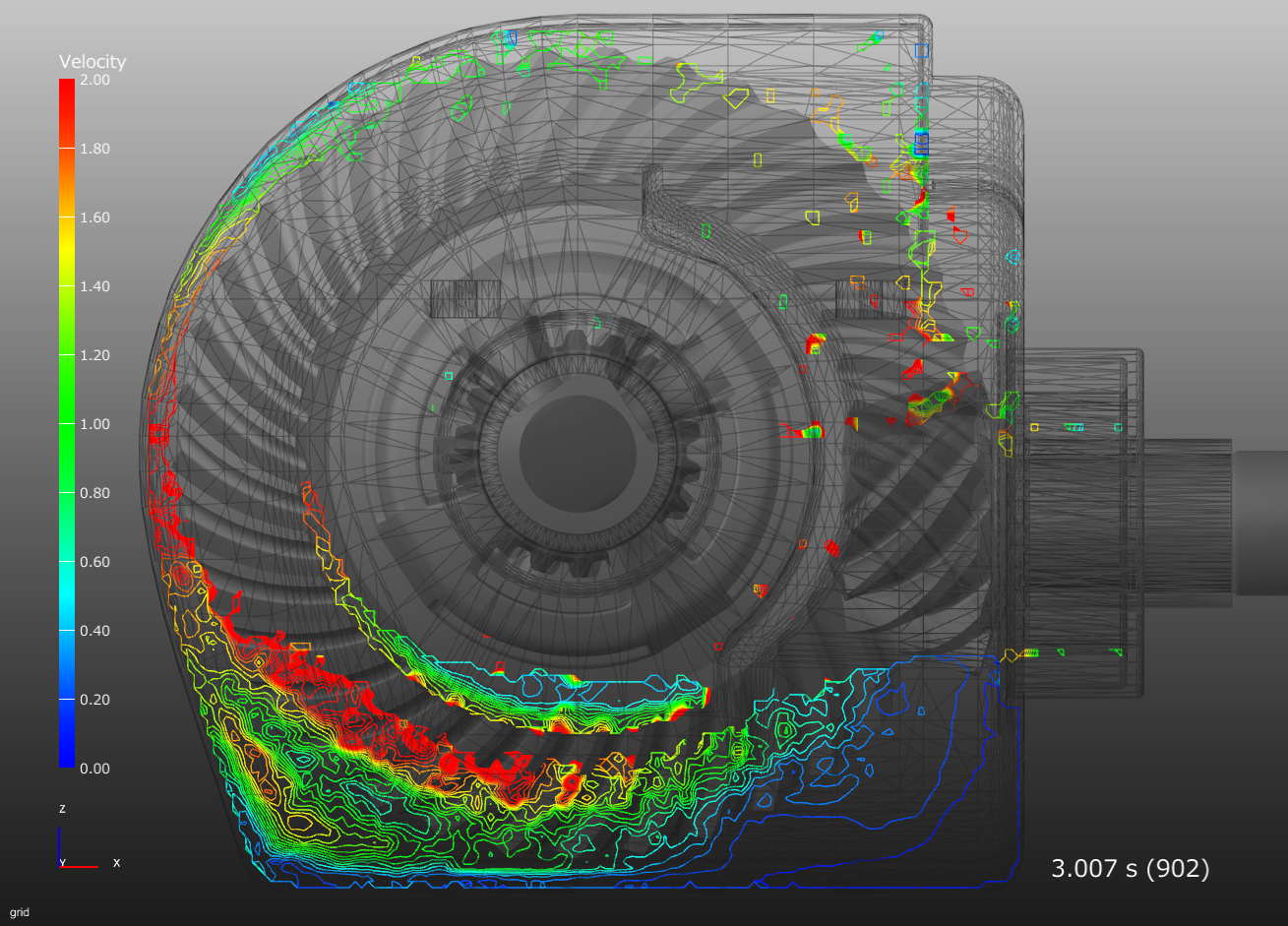
The method allows also to calculate heat transfer and temperature of fluids and solids.
The use of Moving Particle Simulation has diffused for the last years starting from the automotive sector, mainly for powertrain applications, like the simulation of oil splashing and lubrication of engines and transmissions. The benefit of this method is the capability to simulate free-surface flows and liquid jets in very complex geometries, like a complete transmission or engine, in a short modeling and simulation time. This is feasible thanks to the meshless nature of MPS.
Comparisons between Finite Volume CFD and MPS have been carried out by several companies both in terms of modelling time and in terms of accuracy. The results of both the two methods have been validated by comparing the oil flow and distribution predicted by the software against clear cases, that are real prototypes of gearboxes built with transparent housing, in order to be able to visualize the oil flow.
The outcome of the comparison between MPS and Finite Volume CFD is that MPS can do in 2-3 days what Finite Volume CFD can do in 4-5 weeks. MPS reads the CAD geometry as-is, there is no need for simplification and no need for fluid volume extraction and mesh generation. MPS reads the solids parts of the CAD and fills the system with “oil particles”, as you would do with the real transmission or engine of your car. In MPS you do not need to modify the geometry of the gears to be able to deal with the gears meshing. The numerical stability of the method is guaranteed by solid best practices.
Validation of qualitative and quantitative results of MPS against clear cases of gearboxes are available in the literature (Oil Path Prediction and Optimization for High Speed Transmissions). In this paper, presented by Comer Industries at the CAE Conference in 2018, a full comparison between the MPS predictions and laboratory results are presented. The amount of oil and lubrication level of the bearings of a high-speed transmission are compared between the real and the virtual prototypes. The comparison shows very good agreement and demonstrates that the MPS is capable of predicting critical operating conditions, for which bearings lubrication is poor. Being able to predict and correct critical conditions before building any prototype is vital to cut development and delivery time.
Other papers show the validation of MPS results also for the prediction of temperature of pistons and electric motors.
MPS Industrial application
All these examples refer to the automotive industry and for sure this is the main sector of application of MPS. Lubrication of transmissions, bearings in oil splashing or in forced lubrication conditions is for sure the main application. Engine lubrication, gradeability analysis, oil separation and piston cooling are other important applications, but the same method can also be applied to running-wet electric-motors. High power density e-motors require oil injection inside the motor to cool the windings because external cooling is not effective.
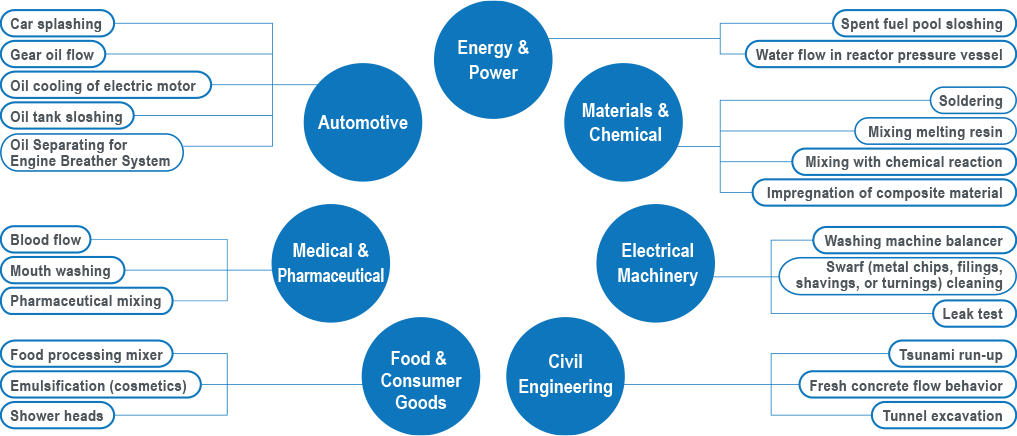
The simulation of free-surface, oil jets and sprays in e-motors and in piston cooling applications is by-far faster using the MPS method than the Finite Volume CFD. MPS can predict heat fluxes / heat transfer coefficients and oil / solid temperature. Low modeling and simulation time with respect to Finite Volume CFD, the capability to handle complex geometries with moving parts and the multi-phase nature of the solver make the MPS advantageous and usable at the early stages of the design process of these systems.
Moving to other kinds of fluids and applications, the MPS method can simulate water, solid particles and even unconventional fluids, for example to simulate contamination of vehicles due to rain, dust and snow. Wading simulation is a common application of MPS, to calculate forces applied by water on the front and bottom parts of a car or to predict the amount of water in vital parts of the under-hood.
Water turbines are another typical application of MPS, for example to design the runner and optimize the power production from Pelton turbines. Also, in this case the geometrical complexity and the free-surface nature of the flow make the use of MPS simpler and faster than other CFD methods. For this kind of application validation of power predictions from MPS are available in the literature.
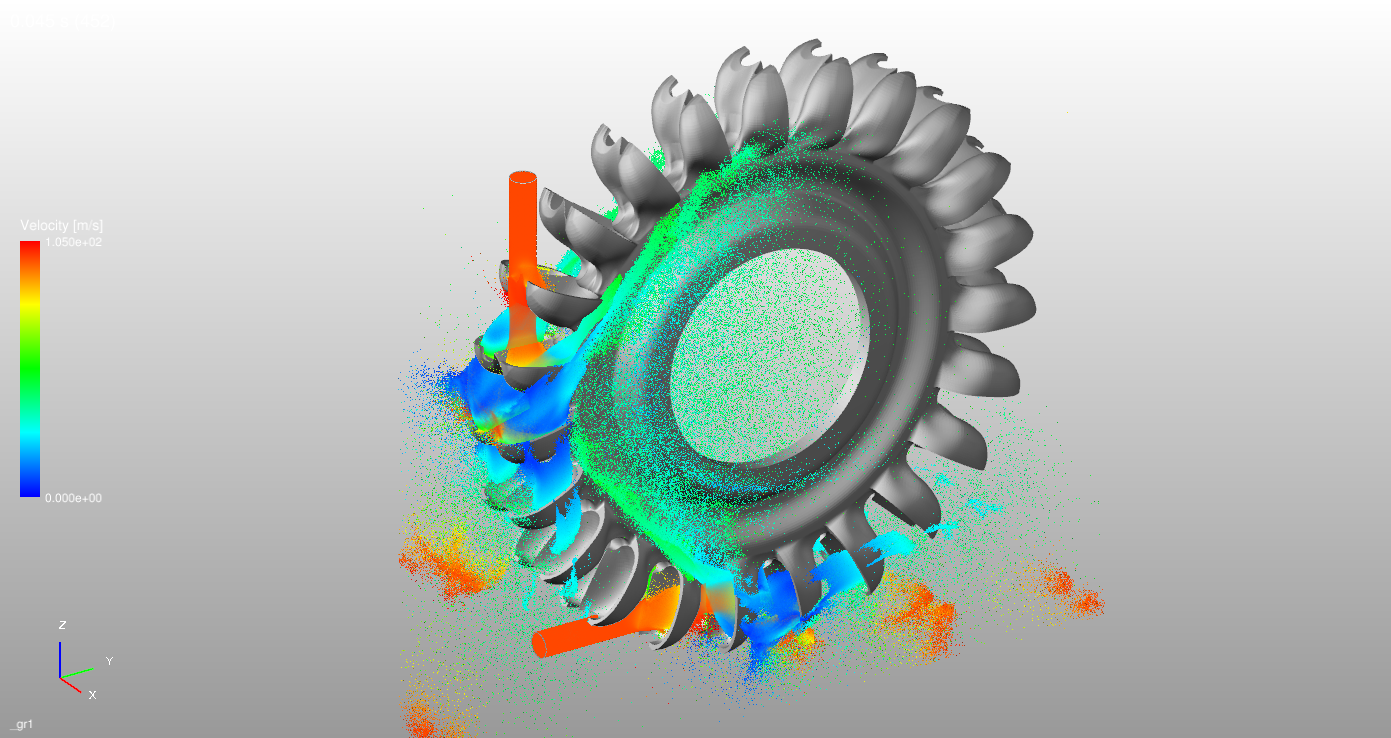
The MPS can also simulate highly viscous fluids, like food, detergents, glue or grease, and that is the reason why it is widely used in the food&beverage, cosmetics and consumer products industry to simulate mixing, filling and pouring processes.
The Moving Particle Simulation is a mesh-free method to solve fluid flows and has a wide range of industrial applications from the automotive to the food&beverage industries. The ease of use and fast-solution make simulations feasible in few days instead of weeks, that is the typical time needed by Finite Volume CFD for multi-phase flow analysis with complex and moving geometries.
After a validation phase, different industrial sectors are adopting this method because it can be used at the early stages of the design process and it allows to drive the design and cut prototyping and testing costs.
If you are interested in learning more about these techniques to find out how to apply them to your design process, contact us, one of our experts will answer all your questions.


